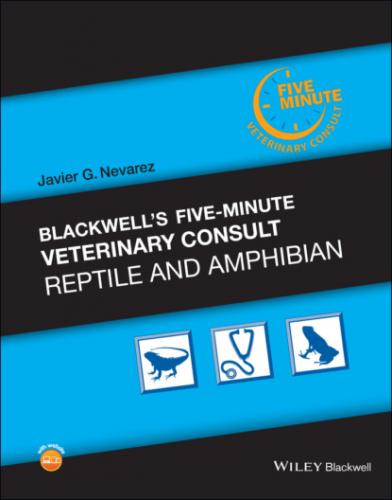COMMENTS
N/A
ZOONOTIC POTENTIAL
N/A
SYNONYMS
N/A
INTERNET RESOURCES
Melissa Kaplan’s Herp Care Collection. Hypoglycemia and Hyperglycemia in Reptiles. http://www.anapsid.org/diabetes.html
Suggested Reading
1 Campbell TW. Clinical pathology. In: Mader DR, Divers SJ, eds. Current Therapy in Reptile Medicine and Surgery. St. Louis, MO: Elsevier Saunders; 2014:70–92.
2 Stahl SJ. Hyperglycemia in reptiles. In: Mader DR, ed. Reptile Medicine and Surgery. 2nd ed. St. Louis, MO: Elsevier Saunders; 2006:822–830.
Author Mads F. Bertelsen, DVM, DVSc, DACZM, DECZM (Zoo Health Management)
Hypervitaminosis A
DEFINITION/OVERVIEW
Hypervitaminosis A is well recognized health concern in chelonians. It can be caused by OTC supplements provided by well‐ meaning owners, parenteral overdosing by veterinarians, or diets with high animal vs. plant‐based (beta carotene) vitamin A levels.
ETIOLOGY/PATHOPHYSIOLOGY
In vertebrates, the vitamin A forms are trans‐retinyl esters, trans‐retinol, ‐retinal and ‐retinoic acid (99% of all vitamin A present in the body), while the major dietary provitamin A carotenoid is beta carotene.
The all‐trans‐vitamin A isomers are the only forms used physiologically.
The liver absorbs and stores preformed vitamin A; at a certain point, storage capacity is reached and toxicity occurs. Other storage sites include adipose tissue, lung, and kidney.
In humans, the retinoid delivery pathway to tissues involves primarily retinol bound to retinol‐binding protein; chylomicrons, very low density lipoprotein, low density lipoprotein, and albumin also provide transport.
Adverse effects in humans include increased bone turnover by suppressing osteoblast activity and stimulating osteoclast formation. This can lead to hypercalcemia, osteoporosis, pathologic fractures, altered skeletal development in children, and skeletal pain.
Vitamin A is fat soluble and high levels can affect metabolism of other fat‐soluble vitamins (D, E, K); with the effects on vitamin D contributing to the aforementioned bone pathology, although stimulation of bone resorption by vitamin A is reported independent of effects on vitamin D.
Vitamin A can have a toxic effect on mitochondrial function and is reported to cause hypothyroidism in mice.
SIGNALMENT/HISTORY
First time owner of reptiles/species and young animals.
Owner using OTC vitamin A drops, OTC multivitamin with vitamin A in formulation other than beta carotene, using cod liver oil or feeding liver to a carnivorous/omnivorous animal.
Occasional issues with extruded diets with inadvertent toxic levels of non‐beta carotene vitamin A.
CLINICAL PRESENTATION
Patients present with vague signs such as anorexia, dehydration, lethargy.
Usually has a dermatological component including: dysecdysis, epidermal flakiness, ulceration, and sloughing.
Bilateral epiphora and periorbital edema may be noted.
Ulcerative stomatitis can be seen.
Secondary bacterial and fungal infections can occur.
Based on pathophysiology, suspect that metabolic bone disease may have interplay with hypervitaminosis A.
RISK FACTORS
Juvenile animal
Reproductively active female
Liver disease
Husbandry
N/A
Others
Iatrogenic dietary or parenteral over supplementation of non‐beta carotene vitamin A.
DIFFERENTIAL DIAGNOSIS
Hypovitaminosis A
Infection
Hepatic or renal disease
UVB or thermal burns
Poor overall husbandry or diet
Improper conspecific arrangement
Metabolic bone disease
DIAGNOSTICS
Liver biopsy for histopathology and testing vitamin A levels (need normal values for the species).
Presumptive diagnosis based upon history and clinical presentation.
PATHOLOGICAL FINDINGS
Hepatic fibrosis
Osteoporosis
Decreased or abnormal bony growth in juvenile animals.
Epidermal ulceration
APPROPRIATE HEALTH CARE
N/A
NUTRITIONAL SUPPORT
Often need assisted feeding
Esophageal feeding tube is often recommended, especially in chelonians with skin sloughing, which makes it difficult to manipulate the head and neck.
CLIENT EDUCATION/HUSBANDRY RECOMMENDATIONS
Proper education about the correct diet and formulation of vitamin A for the species.
Education about differences between water soluble and fat‐soluble vitamins.
